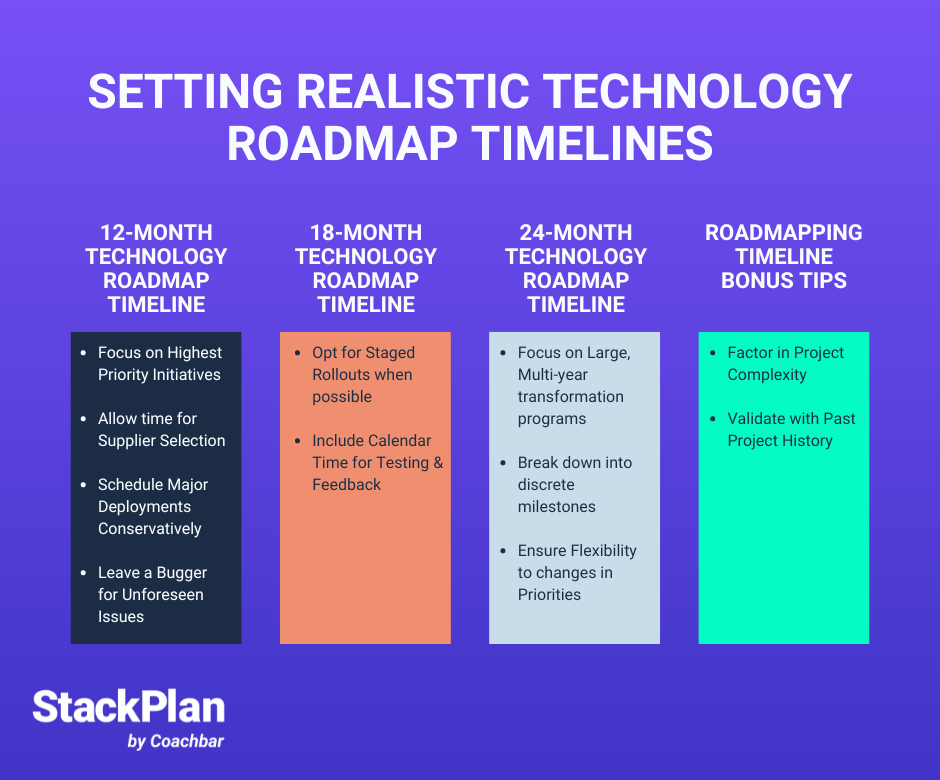- Home
- Software migration
- Setting Realistic Timelines For Your Technology Roadmaps
One of the main pitfalls we see businesses make when creating technology roadmaps is setting unrealistic timelines. It’s all too easy to plan unrealistic project schedules to try to hit business targets sooner, but it’s setting your team up for failure.

When planning a new software implementation, creating achievable timelines is essential to an effective technology roadmap. This guide will show you the best practices for defining realistic project timelines for your 12-, 18-, and 24-month technology roadmaps so you can hit your business’s milestones.
How To Create a 12-month Technology Roadmap Timeline
Your 12-month technology roadmap encompasses your highest-priority initiatives that need to be implemented ASAP. It’s easy to over-schedule the first year of your roadmap and overload your current systems and staff, so it’s important to set realistic, achievable goals.
Focus On Highest Priority Initiatives
If you’ve followed our previous guides on preparing your technology roadmap, you should already have a comprehensive list of goals you want to achieve over the next one to five years.
Figure out the top two to five highest-priority initiatives and focus on those for the first twelve months of the roadmap. It can be difficult to ignore other projects, but you’ll accomplish more by creating priorities and dedicating resources to just a few key items for the next year.
Allow Time For Supplier Selection
Did you know that 55% of businesses that attempt to self-implement new software completely give up on it within 12 months and cancel their subscriptions?
When planning the timelines for these projects, don’t forget to factor in plenty of time to find the right software partners so you can boost your chances of success. Also, shorting the supplier-selection phase may result in acquiring sub-par solutions that don’t support your business objectives.
Schedule Major Deployments Conservatively
It’s always best to allow more time than you think you’ll need for major deployments. Don’t plan major projects to overlap in this first year of your roadmap. Instead, allow plenty of time to achieve milestones so you get quick wins throughout those first twelve months. This will make it much easier to stick to your roadmap long-term.
Leave A Buffer For Unforeseen Issues
No new project ever comes without unforeseen challenges and roadblocks. Even if you think you’ve planned for every eventuality, still plan in buffer time for unforeseen issues to arise.
By having this buffer, your new software implementations won’t run overschedule, and your team will be much more confident in the overall progress of your roadmap.
How To Move On To Your 18-month Roadmap Timeline
Your 18-month roadmap gives you more time to prepare, but it means more uncertainty. At this point, you’ll be working predominantly on future predictions, which means your roadmap needs to be flexible and allow for unpredictability.
Opt For Staged Rollouts When Possible
A staged rollout is a strategic way of implementing new software involving only a percentage of users or team members. This allows you to switch to new software or update an outdated process slowly over a period of time.
This is a safer approach than a full release and gives you time to analyze software stability and performance against your business goals. If the beginning stages of the rollout aren’t going as planned, you have time and space to regroup and pivot your plans.
Include Calendar Time For Testing & Feedback
Your 18-month technology roadmap should also include time for testing and feedback. This gives you time to figure out what’s working and implement necessary improvements.
Without testing and feedback, you run the risk of being stuck with the wrong software or processes. It’s a costly process to go back and undo changes that have already happened. Our research shows that 78% of businesses that suffer a failed implementation give up on the software they were going to use and start over from the beginning.
How to Plan Your 24-month Technology Roadmap Timeline
Your 24-month timeline involves the greatest unknowns. This is where you need strategic planning based on the goals and objectives set out in your 12- and 18-month roadmaps.
Focus On Large, Multi-Year Transformation Programs
A 24-month technology roadmap typically works for projects that lead to major shifts inside your business in terms of processes, staffing, training, and even business outcome expectations (e.g., sales, labor efficiencies, etc.). Give these projects the time they deserve. This way, you’ll have ample time to dedicate to large, multi-stage transformations, and you can plan regular intervals for testing and feedback along the way.
Break Down Into Discrete Milestones
Two years may seem like a long time, but it will go by incredibly quickly. Break down any of your roadmap projects into discrete milestones so you can continuously check on progress as you go.
You might decide to do quarterly, bi-yearly, or even monthly milestones, depending on the project you’re focused on. Think about what kind of milestones will give you the most data on progress, and plan these review sessions into your timeline.
Ensure Flexibility To Changes In Priorities
A lot can change in two years, so your roadmap needs to be flexible to changes in priorities. Maybe your company grows faster than projected, and you need to rethink your technology roadmap. Or, maybe a key stakeholder in the project leaves the company. By building flexibility into your timeline, you can stay one step ahead of virtually any issue.
Bonus Tips For Mapping Out Your Roadmap Timeline
Planning and preparation are key when creating a timeline for your 12-, 18-, and 24-month roadmaps, so here are two more expert tips for ensuring success at every stage.
When planning on developments and new projects on paper, it’s easy to forget about the complexities of the project and schedule too much too soon.
If you’re not sure how long a project might take, here are some important steps:
- Speak to key stakeholders and team members about potential integration challenges they foresee.
- Be willing to adjust timelines based on dependency on different teams.
- Get feedback and support from experienced integration consultants and software coaches with extensive implementation experience.
Think about projects your business has managed in the past, whether it was new software implementation, expanding into new markets, or improving internal processes. Meet with project managers and discuss ideas for improvements, realistic forecasting, and potential challenges. Adjust your current timelines based on lessons learned, and get feedback from as many stakeholders as possible to improve on the previous performance.
Let’s Get Started With Your Short & Long Term Goals
When creating a successful, strategic technology roadmap, defining the right scope and setting realistic schedules builds confidence and sets your team up for success.
One of the most common pitfalls we see businesses fall into is setting unrealistic timelines and scheduling too many changes too quickly to meet objectives.
Need Help Evaluating
your Current Inventory Systems?
Visit our directory of software consultants in the StackPlan Consultant Directory. Vetted consultants are ready to support your business needs.








